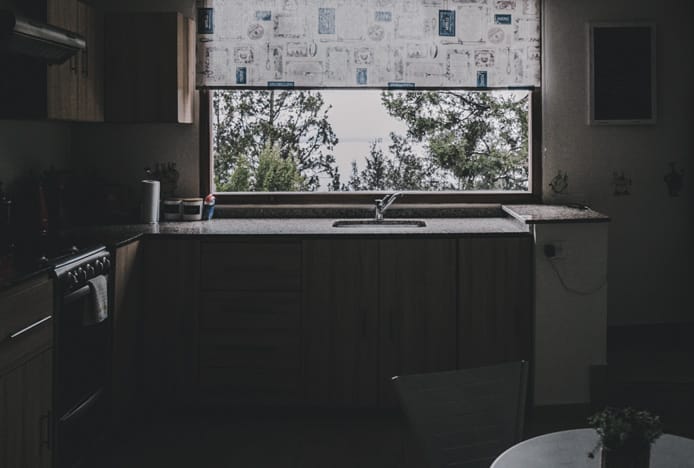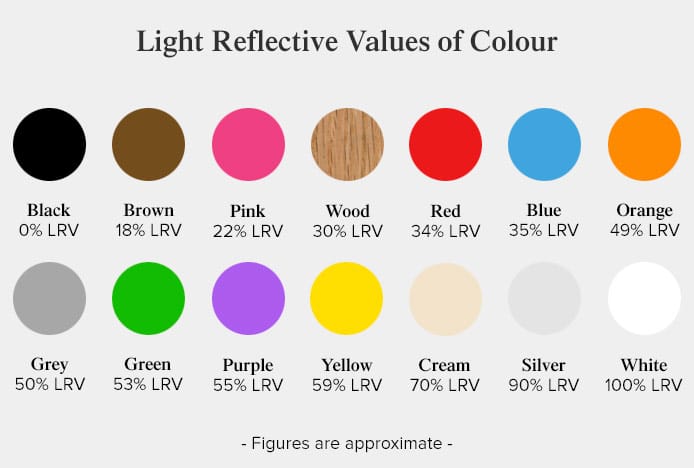Colour And Reflection in Interior Design
By Aurora Commerce, 26th April, 2022
As we all know, sometimes objects don’t always appear as the colour that we truly know them to be. This can be especially true in the home as different environments, light sources and locations can cause the colour from one object to be reflected off another, causing a colour cast reflection.

This is because every colour has a Light Reflective Value or LRV, and when light hits a surface some of the light is absorbed and some of it is reflected. The light that is reflected is the colour of the object that we ourselves see.
Considering how the colour of one object can affect the colour of another is invaluable as part of the interior design process, given the multitude of ways in which fixtures can be coordinated so as to experiment with style and mood.
How Our Eyes Work
Before discussing colour and reflection in more detail, it is worth explaining how the human eye works, as well as what constitutes visible light.
The eye contains two different types of photoreceptors, these being cells that receive light. These photoreceptors convert incoming light into an electrical signal which is then transmitted to the brain. Effectively, they are what allow us the gift of sight.
These two kinds of photoreceptor are known as ‘rods’, which allow us to see in black, white and grey, and ‘cones’, which allow us to see in colour. Because cones only work when there is sufficient light entering the eye, we may not be able to see colours as well in dim lighting. For example, a brightly coloured kitchen full of blue and green fixtures and wooden accents might appear to be made up of different shades of black and grey in low light.

What is Light Reflective Value (LRV)?
Light Reflective Value, or LRV, is used frequently as an industry standard in architecture and interior design, used to make decisions regarding how different colours are paired. This is a measurement of the amount of visible light reflected by an illuminated surface or object.

Theoretically, a black surface will reflect 0% of the light that hits it (in practice, commercially available black paints will reflect slightly more than this) while a white surface will reflect 100%. Different colours in between have different values, hues with an LRV above 50% typically being brighter.

Some of the wider applications of LRV are fairly obvious: white stair rails or stair trim can be much easier to see at night or in dim lighting, while road signs are generally made in yellow so that they are visible in the dark without being too bright for car headlights.
This said, there are several factors that can affect the way in which light is reflected onto other objects. These include the colour of the objects onto which the light is being reflected, the type and texture of materials and the angle and proximity of different objects compared to one another. Some of these will be explored in further detail below.
White & Light Colours
As the most reflective colour, white tends to take on the hues that make up its surroundings. For example, a white kitchen counter may reflect the colour of a bright red or green bar stool. Alternatively, if the same counter is placed in an area with brightly painted walls, then the countertop may appear to be a paler version of the same colour.

This effect can be useful in creating atmospheric interiors. Consider, for example, the pairing of a white kitchen ensemble with an oak floor. Through reflection, any white walls or furnishings are likely to appear warmer with a slight orange tone, which can offset the clinical association from which white interiors can sometimes suffer.
Black & Dark Colours
Conversely, black is the least reflective colour and is less influenced by surrounding objects as a result. This can be an important consideration for those specifically trying to avoid a colour cast, though it should be stated that darker pieces are more likely to cause such hues and tinges in the first instance.

For example, black tabletops or dining chairs in a white kitchen will not be affected by the colour of the walls and floor, nor will they reflect the colour of accompanying white fixtures. This makes creating a stylish two-tone interior much easier, and can also help with colour balance if, for example, you plan to use both darker and lighter furnishings in the same space.
Material & Texture
The colour of an object is not the only factor affecting the amount of light that it reflects. Texture is just as important in determining the level of reflection.
The most straightforward comparison to be made is in terms of matte finishes as opposed to smooth or high-gloss exteriors. Textured items, the rough surfaces of which incline in different ways, cause light to be reflected in multiple directions. By contrast, light bouncing off of smooth objects will be less scattered. In general, matte surfaces have a low LRV while glossy items have a high LRV.
Two items in our range that exemplify this contrast are the Ascot Oak Stool Charcoal Fabric and the Gloss Coco Bar Stool. Despite being available in what is nominally the same colour, the Gloss Coco with its smoother ABS resin seat is shinier than the Ascot, which has a textured fabric upholstery. This in turn affects how reflective the former will be of other furnishings within a kitchen environment.
Metallic items are typically among the most reflective, though there will still be some variance depending on the material and finish. A brushed steel effect is common when it comes to modern appliances such as fridges, taps, kettles and toasters, these often taking on a colour cast from floors or painted walls. Polished chrome surfaces are even more reflective to the extent that these can boast a slight mirrored effect. These will take on much of the surrounding colour, such that chrome bar stools at a kitchen counter may in fact be more discrete than a matte frame would be.

Angle & Proximity
The closer that one object stands to another, the more intense a reflected colour will appear due to there being less diffusion. Distancing furnishings can limit the degree to which colour casting will be noticeable, if for example you have a brightly shaded cabinet which you’d prefer to not interfere with the appearance of a white stool or chair. Meanwhile, going in the other direction and installing warm LEDs under a kitchen cabinet, which then shines down on a wooden floor that in turn reflects onto a white kick-board, giving a warm orangey tone.

Angling different objects also affects the intensity of a colour cast, due to the change in the angle at which light reflects off one surface onto another. This can be especially noticeable with metallic stools or chairs, the apparent colour of which may be entirely different if the item is placed directly adjacent to a vivid object as opposed to being off to one side.

Lush Brushed Steel Bar Stool Red
Other Ways To Use Reflection To Your Advantage
With all of these elements to consider, it is clear that an understanding of LRV and colour reflection can have practical applications when it comes to decor.
Mirrors, which are flat and smooth and so reflect any light hitting them back in the same direction with minimal scattering, will of course show an image of the room in which they are placed. Wall mirrors or mirrored backsplashes can therefore be used to give the illusion of a more sizeable living space, especially worth considering in compact kitchens or dining rooms.

Tetbury Oak Bar Stool Grey Leather
Windows and patio doors are also potentially beneficial, often infusing a light, clean and airy feel. Homes with vibrant, leafy gardens may be bathed in a green hue, adding a welcome and wholly natural splash of colour. Conversely, a windowless but brightly lit room with plenty of wooden surfaces and open brick may instead carry a warm and cosy ambience.

Ascot Bar Stool Charcoal Fabric
Conclusion
Encouraging colour reflection can have a huge impact upon a kitchen environment and change the way in which you perceive different furnishings. Our varied range of bar stools and dining chairs, consisting of numerous materials, styles and shades, is a great place to start when planning a new interior that makes use of differing LRVs.
Recommended Articles
Marsala: Colour of the Year 2015
Colour of the year is Marsala- a deep red brown shade that's super sophisticated..
Radiant Orchid: Colour of the Year 2014
From furniture to fashion, exotic radiant orchid is the key colour of the year..
How to Make Cream Dining Sets Work for Your Kitchen
Nicely neutral, versatile cream dining sets boast soothing tones and classic charm..
Theory of Combining Colours in the Kitchen
Not sure what colours to use in the kitchen? Let the colour wheel guide your decision..
Recent Popular Posts
6 Ways to Use Texture in Your Kitchen
Six easy ways that you can use texture to liven up your kitchen design..
How to Brighten up a Dark Kitchen
Whether your kitchen's a small space, or just poorly lit, brighten it up in 5 steps..
3 Easy Steps to Scandinavian Style in Your Home
Featuring natural materials, clean lines and light spaces, Scandi style is clean and cosy..
How to Create a Cosy Corner in Your Home
Staying in is the new going out! Pop the kettle on and relax in a cosy corner..













